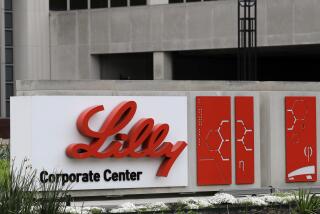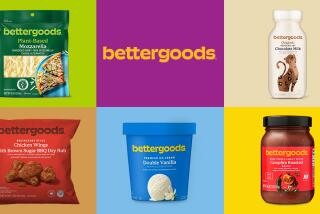Generic Products Sell Strongly at Lucky’s but Drop at Most Markets
WASHINGTON — No-name, plain-label generic products that attracted cost-conscious consumers a decade ago when inflation was surging are all but disappearing from most supermarkets.
Yet at some markets, where generics are still given special emphasis, they continue to sell well. One is Dublin, Calif.-based Lucky Stores, which recently agreed to be acquired by Irvine-based American Stores.
However, with inflation held to moderate levels, most of today’s shoppers are opting in many instances for store brands, which cost a little more than generics but are touted as being a step up in quality.
Generics “definitely have declined very rapidly in popularity over the last several years. They came on strong in the late 1970s when inflation was very high,” said Mike Rourke, a spokesman for the Great Atlantic and Pacific Tea Co. of Montvale, N.J. “People were trading down, trying to get their food dollar to go farther.”
Paul Bernish of the Cincinnati-based Kroger Co. agreed that generics peaked in the years “corresponding to high inflation and unemployment. As the economy has improved . . . their appeal has waned.”
Lucky Stores, however, continues to report strong generic sales.
“We maintain a low-price image, so we try to offer consumers a selection to choose from. We carry generics, private labels and name brand products,” said Lucky spokeswoman Judy Decker.
She said Lucky Stores still have as many as 200 generic items, although that is down slightly from past years.
Mona Doyle, a Philadelphia-based market analyst, identified the Pathmark chain in the Northeast as another chain at which generics continue to sell well. “If the store is willing to stand behind it in a big way, the consumer is still willing to give it a shot,” she said.
Would generics return to popularity if inflation began taking a bigger bite out of the American pocketbook?
Oscar Katov of the Food Marketing Institute doubts it. Consumers who have gone back to name brands have done so because they prefer those products, he said. Where the difference is only a few pennies, they’re unlikely to return to the generics.
Consumers still complain about prices and seek value, Doyle said. But with many stores offering double-coupon values, shoppers often can buy national brands for competitive prices.
In addition, Doyle reported in her Shopper Report newsletter for the supermarket industry that the image of store-brand products is improving among consumers.
“Retailers have gotten the message that store brands don’t have to be an also-ran,” she said.
Pathmark’s Robert Wunderle explains the downfall of generics at other stores this way:
Typically, he said, one chain initiated generics and remained serious about them, while others offered the products on a “me-too” basis and haven’t stuck with them.
Pathmark still carries about 350 items under its No Frills label, Wunderle said, and 53 generics are the No. 1 selling items in their product categories, he said.
For example, Pathmark sells more 2-liter bottles of No Frills cola than any other cola. The same is true for spaghetti, grape jelly and peanut butter, Wunderle said.
Elsewhere, the generics that have remained most popular appear to be non-food items. Kroger’s Bernish agreed that sales of that company’s generic-priced Cost Cutter line remain strongest in such non-food items as paper products.
Doyle also noted a change in the overall supermarket product lineup in recent years.
In the past, national brands have been the top of the line, followed by store brands and then generics. Now, there is a new top layer, the so-called “boutique” offerings of fresh salads, specialty cheeses, deli sections and gourmet items.
A Food Marketing Institute shopper survey in January found that only 41% considered the presence of generics important in a market. By contrast, 76% rated the presence of a deli, bakery or fresh food area as important.
“At one time (generics) got up to 7% of sales, but now they have waned dramatically,” said Rourke, whose company operates under such trade names as A & P, Compass Foods, Kohl’s and Super Fresh. “Generics are now a very minor part of grocery sales, down around 2% or less.”
More to Read
Inside the business of entertainment
The Wide Shot brings you news, analysis and insights on everything from streaming wars to production — and what it all means for the future.
You may occasionally receive promotional content from the Los Angeles Times.










